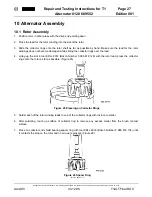
Repair and Testing Instructions for T1 Page 35
Alternator 0120 689 552
Edition 001
All rights rest with Robert Bosch Corp, including patent rights. All rights of use of reproduction and publication rest with R. B. Corp.
UA/ASV
04.12.98
T1ALTFinal.DOC
11 Functional Testing
11.1 General Information
The functional testing of the alternator is broken into two categories, Power Output and Voltage Trace
Evaluation. All of the tests describe here are performed with the voltage regulator installed on the alternator.
11.1.1 Power Output Tests
The power output tests verify the capability of the alternator to produce rated current and voltage at different
speeds. This test requires a test bench of sufficient horsepower to turn a fully loaded alternator at a given
speed. Additionally, the test bench must have the ability to inductively load the alternator to its rated amperage
for an extended amount of time.
The power output test is to be performed anytime the alternator is suspected of being defective or if the
alternator has been disassembled.
11.1.1.1 Test Bench Requirements
To perform the power output test of this series alternator, a test bench must meet the following minimum
criteria.
Characteristic
Minimum Specification
Variable Speed Control
0 - 12,000 RPM
Drive Motor
4 kW (5.4 hp)
Load Bank Capability
170 A @ 28 V for 10 minutes
80 A @ 28 V for 30 minutes
Output Voltage Capability
28 V
11.1.2 Voltage Trace Evaluation
The voltage trace evaluation compares the output of the alternator as viewed on an oscilloscope to know
oscilloscope patterns. The voltage trace evaluation is an important tool for diagnostics of an alternator that
cannot meet the criteria of the power output test. Proper interpretation of the waveforms obtained can lead a
technician to the defective component of a failed alternator. The voltage trace evaluation is done while the
alternator is still mounted to the alternator test bench. Most any oscilloscope, which is capable of accepting the
alternator voltage output, is useable for this evaluation.
11.2 Power Output Testing
11.2.1 Test Bench Mounting
1. Mount the alternator to the test bench per the operating instructions of the test bench manufacturer.
2. Connect the drive system of the test bench to the alternator as per the instructions of the test bench
manufacturer.
Note: Only perform the power output tests with the fan pulley installed on the alternator. Failure to test the
alternator with the correct fan installed can cause the alternator to overheat and damage the internal
components of the alternator.











































